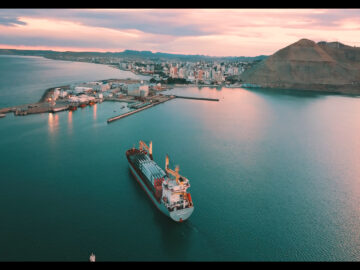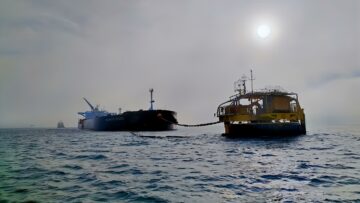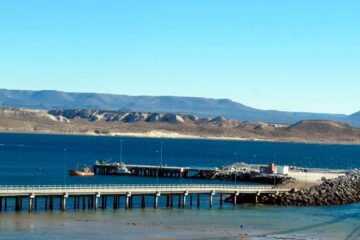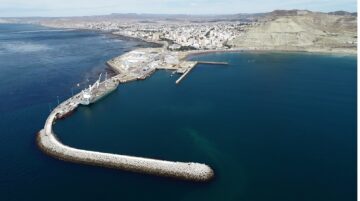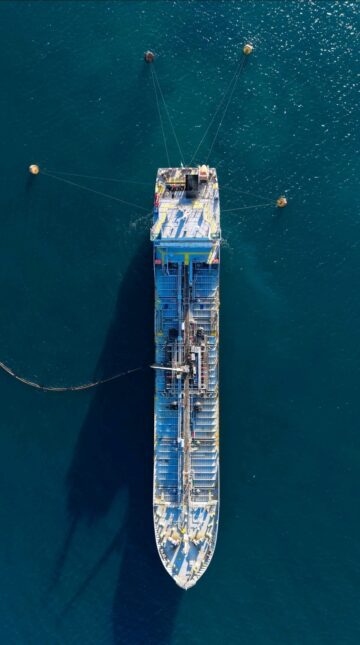The port of Comodoro Rivadavia is the gateway to the Patagonia region of Argentina. It is located in an area of the country that is very important for the oil and fishing industries, south of the Argentine Sea. It is a historic port for hydrocarbons, with one of its oil terminals dating back more than 30 years. It has become an important pillar of offshore exploration in the south of the country. It is at a strategic moment in its history, with the provincial government responsible for the port seeking to promote the shipping industry, tourism, and green ammonia projects.
Committed to sustainability, innovation, and territorial development, the port of Comodoro Rivadavia is joining AIVP in order to strengthen the dialogue between the port and the city, share best practices, and actively contribute to a global network that promotes more inclusive, resilient, and better-connected ports.
Interview with Digna Hernando – Administrator of the Port of Comodoro Rivadavia.
In a few words
AIVP – You have just joined our association. Could you briefly introduce your port to the members of our international network?
Located in the heart of the San Jorge Gulf, the port of Comodoro Rivadavia is a strategic platform for industrial, logistical, and fishing development in Argentine Patagonia. As the main maritime hub in the province of Chubut, it coordinates activities related to oil, metallurgy, fishing, and port services, integrating terminals such as the General Mosconi (YPF) pier, the TERMAP S.A. single buoy, the Antonio Morán deep-water pier, and the Caleta Córdova fishing port. Recently, the reactivation of the free trade zone has made the port one of the most competitive in the country, with total exemptions from taxes and customs duties to encourage investment, local added value, and job creation. This dynamic is complemented by infrastructure projects such as the shipyard and the productive corridors that connect Comodoro to other key cities in the region. Committed to sustainability, innovation, and territorial development, the port of Comodoro Rivadavia is joining AIVP in order to strengthen the dialogue between the port and the city, share best practices, and actively contribute to a global network that promotes more inclusive, resilient, and better-connected ports.
AIVP – What can you bring to the AIVP network and what do you expect from it?
The Port of Comodoro Rivadavia can bring to the network a global vision of port development in complex regional contexts, with strong territorial roots and a great capacity for adaptation. The experience of the port and its staff can be useful to ports located in cities with up to 300,000 inhabitants, by presenting them with examples of port-city coordination and global best practices adapted to local realities. By joining AIVP, the port hopes to strengthen technical and strategic exchanges with other members of the network, access tools and methodologies that promote urban and port resilience, and highlight the challenges and opportunities of Patagonian ports on the international stage. It also seeks to draw inspiration from successful experiences in social integration, energy transition, and coastal heritage enhancement to enrich its own transformation processes. With a strong territorial focus and a commitment to sustainable development, the port of Comodoro Rivadavia joins AIVP to actively contribute to the construction of more inclusive, innovative ports that are connected to their communities.
AIVP – In May 2024, the provincial government of Chubut presented a law to promote the shipbuilding industry, launched a call for tenders, and awarded the port’s shipyard. What does this mean for the port?
The enactment of Law IX No. 170 on the promotion of the shipbuilding industry in May 2024, as well as the call for tenders and the award of the Comodoro Rivadavia shipyard, mark an important milestone for the port and the city. This initiative not only recovers a long-neglected strategic infrastructure but also makes Comodoro an industrial hub with a regional impact.
For the port, this means expanding its operational and technical capacity, with the integration of repair, maintenance, and shipbuilding services that strengthen its logistical role in the South Atlantic. Coordination with sectors such as fishing, oil, and tourism will consolidate a more diversified and competitive productive ecosystem. From an urban perspective, the shipyard represents a concrete opportunity for economic recovery, the creation of skilled jobs, and the strengthening of the local value chain. The law gives priority to the hiring of regional labor, encourages the creation of SMEs, and promotes technical training in partnership with educational and scientific institutions. In addition, this public policy strengthens the link between the port and the city, restoring Comodoro Rivadavia’s maritime identity and opening up new opportunities for social integration, innovation, and sustainable development. Together, the law and the shipyard award consolidate a vision for the future that combines infrastructure, knowledge, and territory, in line with the principles of resilience and collaborative governance promoted by the AIVP network.
AIVP – You organized a day entitled “Climate Change and Decentralized Production” at the end of October 2024. What are the port’s current and future projects in this area?
The day consolidated the commitment to energy transition and sustainability. The event brought together public, private, and academic stakeholders to discuss carbon footprint, clean energy, financing, and projects with a local impact. Currently, the port is continuing to install solar panels on the administrative building, with the aim of producing energy for its own consumption. This first step will be gradual and will extend to other operational areas, marking the beginning of a decentralized energy model. In addition, coordination with large users is encouraged in order to facilitate access to credit lines for the integration of renewable equipment, thereby reducing costs and emissions. In the future, the port plans to expand its energy infrastructure according to criteria of efficiency and resilience, in accordance with the law on the promotion of distributed generation. This regulation requires that, as of January 2025, public buildings integrate renewable sources and that large consumers cover at least 20% of their demand with clean energy. The strategy includes partnerships with institutions such as Comodoro Conocimiento, TES, and the Bank of Chubut to promote collaborative projects, technical training, and community participation. The port seeks to position itself as a regional benchmark for energy innovation, integrating environmental sustainability and economic development. These actions strengthen the link between the port and the city and align Comodoro Rivadavia with the principles of the AIVP: more responsible, more resilient ports that are more connected to their communities.


